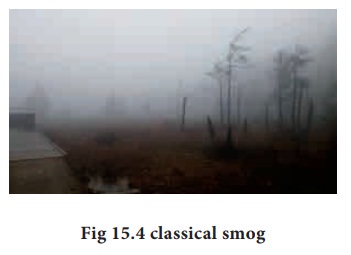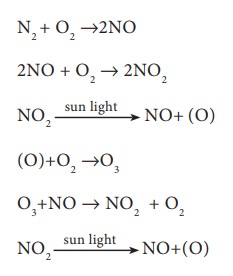Environmental Chemistry - Smog - Air pollution | 11th Chemistry : UNIT 15 : Environmental Chemistry
Chapter: 11th Chemistry : UNIT 15 : Environmental Chemistry
Smog - Air pollution
Smog
Smog is a combination of smoke and fog which forms droplets that remain suspended in the air.

Smog is a chemical mixture of gases that forms a brownish yellow haze over urban cities.Smog mainly consists of ground level ozone, oxides of nitrogen, volatile organic compounds, SO2, acidic aerosols and gases, and particulate matter.
There are two types of smog. One is Classical smog caused by coal smoke and fog , second one is photo chemical smog caused by photo chemical oxidants.They are discussed below in detail.
(i) Classical smog or London smog
Classical smog was first observed in London in December 1952 and hence it is also known as London smog. It consists of coal smoke and fog.
It occurs in cool humid climate. This atmospheric smog found in many large cities. The chemical composition is the mixture of SO2, SO3 and humidity. It generally occurs in the morning and becomes worse when the sun rises.
This is mainly due to the induced oxidation of SO2 to SO3, which reacts with water yielding sulphuric acid aerosol.
Chemically it is reducing in nature because of high concentration of SO2 and so it is also called as reducing smog.
Effects of classical smog:
a. Smog is primarily responsible for acid rain.
b. Smog results in poor visibility and it affects air and road transport.
c. It also causes bronchial irritation.
ii)Photo chemical smog or Los Angel Smog
Photo Chemical smog was first observed in Los Angels in 1950. It occurs in warm, dry and sunny climate.This type of smog is formed by the combination of smoke, dust and fog with air pollutants like oxides of nitrogen and hydrocarbons in the presence of sunlight.
It forms when the sun shines and becomes worse in the afternoon. Chemically it is oxidizing in nature because of high concentration of oxidizing agents NO2 and O3, so it is also called as oxidizing smog.
Photo chemical smog is formed through sequence of following reactions.
N2 + O2 →2NO
2NO + O2 → 2NO2

(O)+O2 →O3
O3+NO → NO2 + O2
NO and O3 are strong oxidizing agent and can react with unburnt hydrocarbons in polluted air to form formaldehyde,acrolein and peroxy acetyl nitrate(PAN).
Effects of photo chemical smog
The three main components of photo chemical smog are nitrogen oxide, ozone and oxidised hydro carbon like formaldehyde(HCHO), Acrolein (CH2=CH-CHO),peroxy acetyl nitrate (PAN).
Photochemical smog causes irritation to eyes, skin and lungs, increase in chances of asthma.
High concentrations of ozone and NO can cause nose and throat irritation, chest pain, uncomfortable in breathing, etc.
PAN is toxic to plants, attacks younger leaves and cause bronzing and glazing of their surfaces
It causes corrosion of metals stones, building materials and painted surfaces.
Control of Photo chemical smog
The formation of photochemical smog can be suppressed by preventing the release of nitrogen oxides and hydrocarbons into the atmosphere from the motor vehicles by using catalytic convertors in engines. Plantation of certain trees like Pinus, Pyrus, Querus Vitus and juniparus can metabolise nitrogen oxide.
Related Topics